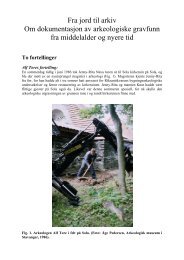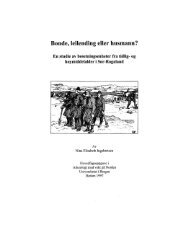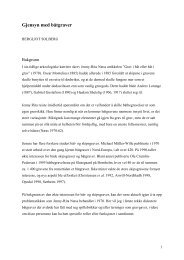Lye i Time på Jæren i Sørvest-Norge – et glemt ... - Jenny-Rita
Lye i Time på Jæren i Sørvest-Norge – et glemt ... - Jenny-Rita
Lye i Time på Jæren i Sørvest-Norge – et glemt ... - Jenny-Rita
Create successful ePaper yourself
Turn your PDF publications into a flip-book with our unique Google optimized e-Paper software.
The largest gold hoard from the Roman and Migration Periods found in Norway come<br />
from Oma, 2 km south of <strong>Lye</strong>. 626 grams of gold, in the shape of rings and rods, was<br />
in 1896 found in a stone fence surrounding a group of Iron Age houses. It is tempting<br />
to see this depot in connection with the smith’s grave from Vestly, indicating a local<br />
workshop for a gold smith. A gold imitation of a Roman medallion found at Mauland<br />
(for the emperor Valens, 375-378 AD) may have been made at this workshop for a<br />
local chieftain. So may even some of the gold bracteates found near <strong>Lye</strong>/Vestly. It has<br />
long been accepted that some types of brooches and local variants of Style I were<br />
made at <strong>Jæren</strong>.<br />
From <strong>Lye</strong> and Haugland come two of the three Scandinavian wrist clasps that are<br />
clearly imitating the fastening technique of the English clasps, indicating a local<br />
production. It has even been suggested that the two glass beakers from Nærland and<br />
Rimestad were locally made. During the excavation in 1969-1970 at <strong>Lye</strong> indications<br />
of an iron smithy from the Iron Age was found, and it is suggested that iron from<br />
excavated iron ovens at neighbouring farms where brought to <strong>Lye</strong> for further<br />
processing. The indication of workshops and production sites fits well with recent<br />
finds from other central places in Scandinavia.<br />
The river Hå is running from the highlands to the coast at Hå/Nærland/Njærheim is<br />
connecting the central area of <strong>Lye</strong>/Vestly and that near the river mouth where it was a<br />
harbour. From <strong>Lye</strong> pathways led to the inland to areas with iron production, pastures<br />
and hunting grounds, and from the central area at the coast contacts where established<br />
with neighbouring centres along the coast and across the North Sea.<br />
Bjørn Myhre, Arkeologisk museum i Stavanger, P.O. Box 478, N-4002 Stavanger,<br />
Norway. Telephone (+47) 51846077, mobile (+47) 90086094, e-mail<br />
bmy@ark.museum.no.<br />
Key words: Roman and Migration Periods, Production Sites, Political and Religious<br />
centres, Central places<br />
Emneord: Romertid og folkevandringstid, produksjonssteder, politiske og religiøse<br />
sentre, sentralsteder<br />
I 1969-70 led<strong>et</strong> <strong>Jenny</strong>-<strong>Rita</strong> en utgravning av en liten gruppe gravminner fra eldre<br />
jernalder <strong>på</strong> gården <strong>Lye</strong> i <strong>Time</strong> kommune <strong>på</strong> <strong>Jæren</strong>, og hun skrev en kort melding om<br />
undersøkelsen i Fra haug ok heidni 1969. De enkle gravfunnene som den gang kom<br />
for dagen, er merkelig nok de eneste vi har bevart fra denne gården som sannsynligvis<br />
har vært <strong>et</strong> sentralt sted <strong>på</strong> <strong>Jæren</strong> i romertid og folkevandringstid. Denne <strong>på</strong>standen<br />
bygges dels <strong>på</strong> den store samlingen av store gravhauger som fortsatt ligger inntakt,<br />
dels <strong>på</strong> enkelte gjenstanders og fornminners spesielle karakter, og ikke minst <strong>på</strong> de<br />
mange rike funnene fra romertid og folkevandringstid fra nabogårdene. Også<br />
tolkningen av gårdsnavn<strong>et</strong> <strong>Lye</strong> tyder <strong>på</strong> at d<strong>et</strong>te har vært <strong>et</strong> viktig samlingssted i<br />
jernalderen. For meg har <strong>Lye</strong> en spesiell b<strong>et</strong>ydning siden d<strong>et</strong> sentrale bruk<strong>et</strong> <strong>på</strong> gården<br />
har tilhørt nære slektninger siden 1950-tall<strong>et</strong>, og jeg har gjennom mange besøk hatt<br />
anledning til å studere sporene <strong>et</strong>ter tidlig bebyggelse <strong>på</strong> sted<strong>et</strong>.<br />
2






